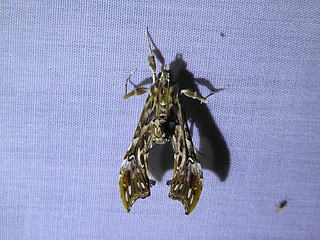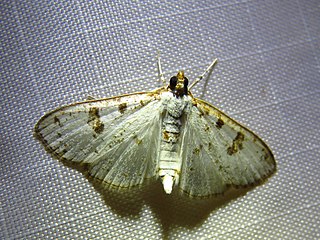
Pyraustinae is a large subfamily of the lepidopteran family Crambidae, the crambid snout moths. It currently includes about 1,280 species Most of them tropical but some found in temperate regions including both North America and Europe.

Palpita vitrealis, common name jasmine moth or white pearl, is a species of moth of the family Crambidae.

Palpita is a genus of moths of the family Crambidae. Members of the moth genus Stemorrhages may be very similar in appearance.

Rhectosemia is a genus of moths of the family Crambidae described by Julius Lederer in 1863.
Eoophyla persimilis is a moth in the family Crambidae. It was described by Eugene G. Munroe in 1959. It is found on New Guinea.
Gyros powelli is a moth in the family Crambidae. It was described by Eugene G. Munroe in 1959. It is found in North America, where it has been recorded from California.

Palpita aenescentalis is a moth in the family Crambidae. It was described by Eugene G. Munroe in 1952. It is found in North America, where it has been recorded from Illinois, Indiana, Maine, Maryland, North Carolina, North Dakota, Ohio, Oklahoma, Ontario, Quebec, South Carolina, Tennessee, Virginia and Wisconsin.
Palpita braziliensis is a moth in the family Crambidae. It was described by Eugene G. Munroe in 1959. It is found in Santa Catarina, Brazil.
Palpita forficifera is a moth in the family Crambidae. It was described by Eugene G. Munroe in 1959. It is found in Santa Catarina, Brazil.
Palpita kimballi, or Kimball's palpita moth, is a moth in the family Crambidae. It was described by Eugene G. Munroe in 1959. It is found in North America, where it has been recorded from Alabama, Florida, Georgia, Louisiana, North Carolina, Oklahoma, South Carolina, Tennessee and Virginia.
Palpita travassosi is a moth in the family Crambidae. It was described by Eugene G. Munroe in 1959. It is found in São Paulo, Brazil.
Palpita trifurcata is a moth in the family Crambidae. It was described by Eugene G. Munroe in 1959. It is found in São Paulo, Brazil.
Palpita viettei is a moth in the family Crambidae. It was described by Eugene G. Munroe in 1959. It is found on Guadeloupe in the Caribbean.
Palpita cincinnatalis is a moth in the family Crambidae. It was described by Eugene G. Munroe in 1952. It is found in North America, where it has been recorded from Florida, Illinois and Ohio.

Palpita freemanalis, or Freeman's palpita moth, is a moth in the family Crambidae. It was described by Eugene G. Munroe in 1952. It is found in North America, where it has been recorded from Alabama, Illinois, Indiana, Louisiana, Maryland, Mississippi, North Carolina, Oklahoma, South Carolina, Tennessee and Texas.
Palpita jansei is a moth in the family Crambidae. It was described by Eugene G. Munroe in 1977. It is found in Papua New Guinea.
Palpita varii is a moth in the family Crambidae. It was described by Eugene G. Munroe in 1977. It is found in Seram, Indonesia.

Palpita illibalis, the inkblot palpita moth, is a moth in the family Crambidae. It was described by Jacob Hübner in 1818. It is found in North America, where it has been recorded from Alabama, Florida, Georgia, Maryland, Mississippi, North Carolina, Ohio, Oklahoma, Pennsylvania, South Carolina, Tennessee, Virginia and West Virginia.
Palpita isoscelalis is a moth in the family Crambidae. It was described by Achille Guenée in 1854. It is found in South America and on the Antilles.

Margaroniini is a tribe of the species-rich subfamily Spilomelinae in the pyraloid moth family Crambidae. The tribe was erected by Charles Swinhoe and Everard Charles Cotes in 1889, originally as family Margaronidae.






